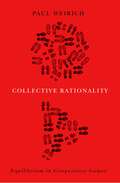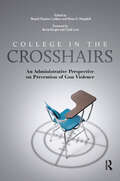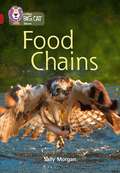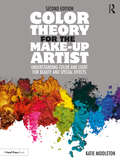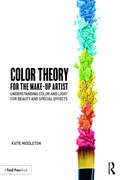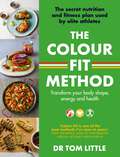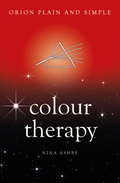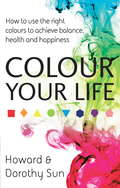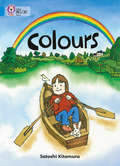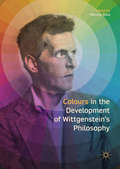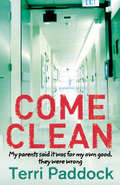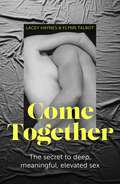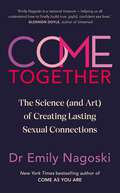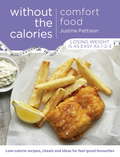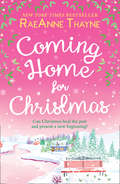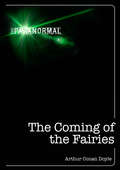- Table View
- List View
Collective Rationality: Equilibrium in Cooperative Games
by Paul WeirichGroups of people perform acts that are subject to standards of rationality. A committee may sensibly award fellowships, or may irrationally award them in violation of its own policies. A theory of collective rationality defines collective acts that are evaluable for rationality and formulates principles for their evaluation. This book argues that a group's act is evaluable for rationality if it is the products of acts its members fully control. It also argues that such an act is collectively rational if the acts of the group's members are rational. Efficiency is a goal of collective rationality, but not a requirement, except in cases where conditions are ideal for joint action and agents have rationally prepared for joint action. The people engaged in a game of strategy form a group, and the combination of their acts yields a collective act. If their collective act is rational, it constitutes a solution to their game. A theory of collective rationality yields principles concerning solutions to games. One principle requires that a solution constitute an equilibrium among the incentives of the agents in the game. In a cooperative game some agents are coalitions of individuals, and it may be impossible for all agents to pursue all incentives. Because rationality is attainable, the appropriate equilibrium standard for cooperative games requires that agents pursue only incentives that provide sufficient reasons to act. The book's theory of collective rationality supports an attainable equilibrium-standard for solutions to cooperative games and shows that its realization follows from individuals' rational acts. By extending the theory of rationality to groups, this book reveals the characteristics that make an act evaluable for rationality and the way rationality's evaluation of an act responds to the type of control its agent exercises over the act. The book's theory of collective rationality contributes to philosophical projects such as contractarian ethics and to practical projects such as the design of social institutions.
College in the Crosshairs: An Administrative Perspective on Prevention of Gun Violence
by Brandi Hephner LaBanc Brian O. HemphillGun violence – whether rampage shootings, homicides or suicides – is a potential reality all campuses have to face. This book provides leaders in higher education – and particularly those in student affairs – with data about past incidents, an analysis of trends, and background on the national debate about gun policies and how they impact colleges, state by state. It importantly raises issues about student psychological development, mental health, and the prevalence of alcohol and substance abuse on campus, to better inform discussion about allowing guns on campus and concealed carry. It concludes by sharing strategies for averting gun-related tragedies, and offering models for responding when they occur, based on lessons learned and best practices. The book addresses concealed carry legislation and its impact on campus policies by state, examining the concerns of administrators as they discharge their duty of care to students and comply with legal and regulatory frameworks. Asking “Are our students developmentally ready to make a morally sophisticated, life-changing decision to use firearms in response to a real or perceived threat?”, it offers important perspectives and scientific data, so far absent from the debate, to shape the ongoing conversation with lawmakers and the public about what it takes to keep college communities safe.In addressing risk and prevention, contributors cover the relationship between violence and mental health, and the need to establish comprehensive strategic plans and a preventative framework that promotes help-seeking for those in need before they reach the point of crisis, as well as a campus-wide risk assessment team, stressing the importance of cultivating a community-wide approach to campus safety by empowering members to report suspicious behavior. They also offer guidance on improving effective behavior intervention and case management processes.The book concludes by outlining best practices, and providing guidance on developing an emergency plan, practicing and testing systems, and creating a robust communications strategy. Individual chapters focus on how small colleges with limited resources can develop effective plans into by partnering with local agencies; as well as on the steps that community colleges – who generally lack resident advisors and residential staff, and whose students are far more dispersed – can take to diminish risk and respond promptly and professionally to a crisis.This is an essential guide for all higher education leaders concerned about preventing violence on our campuses, and a call to action.
College in the Crosshairs: An Administrative Perspective on Prevention of Gun Violence
Gun violence – whether rampage shootings, homicides or suicides – is a potential reality all campuses have to face. This book provides leaders in higher education – and particularly those in student affairs – with data about past incidents, an analysis of trends, and background on the national debate about gun policies and how they impact colleges, state by state. It importantly raises issues about student psychological development, mental health, and the prevalence of alcohol and substance abuse on campus, to better inform discussion about allowing guns on campus and concealed carry. It concludes by sharing strategies for averting gun-related tragedies, and offering models for responding when they occur, based on lessons learned and best practices. The book addresses concealed carry legislation and its impact on campus policies by state, examining the concerns of administrators as they discharge their duty of care to students and comply with legal and regulatory frameworks. Asking “Are our students developmentally ready to make a morally sophisticated, life-changing decision to use firearms in response to a real or perceived threat?”, it offers important perspectives and scientific data, so far absent from the debate, to shape the ongoing conversation with lawmakers and the public about what it takes to keep college communities safe.In addressing risk and prevention, contributors cover the relationship between violence and mental health, and the need to establish comprehensive strategic plans and a preventative framework that promotes help-seeking for those in need before they reach the point of crisis, as well as a campus-wide risk assessment team, stressing the importance of cultivating a community-wide approach to campus safety by empowering members to report suspicious behavior. They also offer guidance on improving effective behavior intervention and case management processes.The book concludes by outlining best practices, and providing guidance on developing an emergency plan, practicing and testing systems, and creating a robust communications strategy. Individual chapters focus on how small colleges with limited resources can develop effective plans into by partnering with local agencies; as well as on the steps that community colleges – who generally lack resident advisors and residential staff, and whose students are far more dispersed – can take to diminish risk and respond promptly and professionally to a crisis.This is an essential guide for all higher education leaders concerned about preventing violence on our campuses, and a call to action.
Collins Big Cat, Band 14/Ruby: Food Chains (PDF)
by Sally MorganAll living things need food to survive. Find out who eats whom, and how we all link together to form a food chain. • Ruby/Band 14 books give increasing opportunities for children to develop their skills of inference and deduction. • Text type: an information book • Curriculum links: science, geography
Color Theory for the Make-up Artist: Understanding Color and Light for Beauty and Special Effects
by Katie MiddletonColor Theory for the Make-up Artist: Understanding Color and Light for Beauty and Special Effects (Second Edition) analyzes and explains traditional color theory for fine artists and applies it to make-up artistry. This beautifully illustrated guide begins with the basics of color theory – why we see color, how to categorize and identify color, and relationships between colors – and relates these concepts to beauty and special effects make-up. The book provides a wealth of information, including how to mix flesh tones by using only primary colors, how these colors in paints and make-up are sourced and created, the reason for variations in skin colors and undertones, and how to identify and match these using make-up while choosing flattering colors for the eyes, lips, and cheeks. Colors found inside the body are explained for special effects make-up, like why we bruise, bleed, or appear sick. Ideas and techniques are also described for painting prosthetics, in addition to using color as inspiration in make-up designs. The book also discusses how lighting affects color on film, television, theater, and photography sets, and how to properly light a workspace for successful applications. The second edition features: A brand-new chapter on color inspiration in make-up and design Additional and updated diagrams More real-life application photos and demonstrations, including new examples of tattoo covering and prosthetic painting using optical mixtures, airbrush, and stippling Expanded discussion on undertones, skin variations, color correction, pigments, colored gels, and more Filled with stunning photography and practical information, Color Theory for the Make-up Artist provides guidance and inspiration for both professionals and beginners who wish to train their eye further to understand and recognize distinctions in color.
Color Theory for the Makeup Artist: Understanding Color and Light for Beauty and Special Effects
by Katie MiddletonColor Theory for the Make-up Artist: Understanding Color and Light for Beauty and Special Effects analyzes and explains traditional color theory for fine artists and applies it to the make-up artist. This book is suitable for both professionals and beginners who wish to train their eye further to understand and recognize distinctions in color. It explains why we see color, how to categorize and identify color, relationships between colors, and it relates these concepts to beauty and special effects make-up. The book teaches the reader how to mix flesh tones by using only primary colors, and explains how these colors in paints and make-up are sourced and created. It also discusses the reason for variations in skin colors and undertones, and how to identify and match these using make-up, while choosing flattering colors for the eyes, lips, and cheeks. Colors found inside the body are explained for special effects make-up, like why we bruise, bleed, or appear sick. Ideas and techniques are also described for painting prosthetics, in addition to using color as inspiration in make-up designs. The book also discusses how lighting affects color on film, television, theater, and photography sets, and how to properly light a workspace for successful applications.
Color Theory for the Makeup Artist: Understanding Color and Light for Beauty and Special Effects
by Katie MiddletonColor Theory for the Make-up Artist: Understanding Color and Light for Beauty and Special Effects analyzes and explains traditional color theory for fine artists and applies it to the make-up artist. This book is suitable for both professionals and beginners who wish to train their eye further to understand and recognize distinctions in color. It explains why we see color, how to categorize and identify color, relationships between colors, and it relates these concepts to beauty and special effects make-up. The book teaches the reader how to mix flesh tones by using only primary colors, and explains how these colors in paints and make-up are sourced and created. It also discusses the reason for variations in skin colors and undertones, and how to identify and match these using make-up, while choosing flattering colors for the eyes, lips, and cheeks. Colors found inside the body are explained for special effects make-up, like why we bruise, bleed, or appear sick. Ideas and techniques are also described for painting prosthetics, in addition to using color as inspiration in make-up designs. The book also discusses how lighting affects color on film, television, theater, and photography sets, and how to properly light a workspace for successful applications.
The Colour-Fit Method: The secret nutrition and fitness plan used by elite athletes that will transform your body shape, energy and health
by Dr Tom Little'Colour-Fit is an amazing resource that helped me realise one of sports greatest achievements'Wes Morgan, Captain of Leicester City Premier League winning teamThe Colour-Fit Method has only been available to those in professional sport - a secret weapon for athletes to optimise body shape, health and performance. Now, Colour-Fit's founder Dr Tom Little lets you in on the secret, too.The Colour-Fit Method is a revolutionary approach to nutrition and fitness. With over 90 recipes and meal plans, and multiple tailored training and nutrition plans to suit a range of goals, the simple, sustainable and evidence-based method outlined in The Colour-Fit Method will help you to look and feel better, perform at your best and lead a healthier and more active life.Dr Tom Little is a performance and health specialist with over twenty years' professional experience. His Colour-Fit method has rapidly become a revolutionising force in elite sport, having been used by many of the world's best-loved teams, including Manchester City, Arsenal, Chelsea, St Helens, Welsh Rugby Union, Saracens, Melbourne Demons, Sri Lankan Cricket and Manchester United, in addition to multiple motor sport, triathlon and combat athlete champions.'Colour-Fit is one of the best methods I've seen in years'Tony Strudwick, Head of Performance, Arsenal Academy and Welsh FA
Colour Therapy
by Pauline WillsWe all know what a strong effect colour has on us. In fact, colour healing has been used by mankind throughout history. The ancient Egyptians, Greeks and Romans all used colour in a variety ways to treat different ailments. This accessible introduction gives practical advice on how to make the most creative use of colour in what we wear, our surroundings and how certain colours can be effective in treating particular health conditions.
Colour Therapy, Orion Plain and Simple (Plain and Simple)
by Nina AshbyWe are surrounded by color, and we largely take it for granted. Each color, hue, tint, and shade has characteristics that affect our physical, emotional, and spiritual lives. Learn how to use color knowledge to enhance every aspect of your life, from health to relationships.This book provides a full spectrum of information from the practical to the spiritual. Find out how to decorate with color to create specific moods. Learn how to dress for success and interpret others' personalities by the colors they wear. Improve your health by using colored lights and color-based meditations and visualizations and eating foods of a certain color.The author provides information on each color of the spectrum and discusses color in relation to astrology, the chakras, the aura, and divination. Exercises for healing with color are also provided.
Colour Your Life: How to use the right colours to achieve balance, health and happiness
by Dorothy Sun Howard SunColour has been used for thousands of years to represent an individual's mental and emotional state. The colours that we surround ourselves with provide an insight and allow for a deeper exploration into the inner self. Used positively, colour can have a profound healing quality, enhance our well-being and improve our lives.Howard and Dorothy Sun have been working as colour therapists for over twenty years and created Living Colour, a colour awareness and personal growth organisation. Colour Your Life explains how colour can be used to promote health, healing and personal growth. Discover how to do your own Colour Reflection Reading, learn about your aura and chakra colours and discover how colour in your life can be the answer to spiritual growth and well-being.
Colours: Band 04/blue (Collins Big Cat)
by Satoshi KitamuraA simple text where a visit to an art show causes a girl to imagine what the world would be like if it was wholly yellow, red or blue. Realising that the world actually consists of all the colours of the rainbow, she paints lots of multicoloured pieces of art herself.
Colours in the development of Wittgenstein’s Philosophy
by Marcos SilvaThis book presents and discusses the varying and seminal role which colour plays in the development of Wittgenstein’s philosophy. Having once said that “Colours spur us to philosophize”, the theme of colour was one to which Wittgenstein returned constantly throughout his career. Ranging from his Notebooks, 1914-1916 and the Tractatus Logico-Philosophicus to the posthumously published Remarks on Colours and On Certainty, this book explores how both his view of philosophical problems generally and his view on colours specifically changed considerably over time. Paying particular attention to his so-called intermediary period, it takes a case-based approach to the presentation of colour in texts from this period, from Some Remarks on Logical Form and Philosophical Remarks to his Big Typescript.
Colours in the development of Wittgenstein’s Philosophy
by Marcos SilvaThis book presents and discusses the varying and seminal role which colour plays in the development of Wittgenstein’s philosophy. Having once said that “Colours spur us to philosophize”, the theme of colour was one to which Wittgenstein returned constantly throughout his career. Ranging from his Notebooks, 1914-1916 and the Tractatus Logico-Philosophicus to the posthumously published Remarks on Colours and On Certainty, this book explores how both his view of philosophical problems generally and his view on colours specifically changed considerably over time. Paying particular attention to his so-called intermediary period, it takes a case-based approach to the presentation of colour in texts from this period, from Some Remarks on Logical Form and Philosophical Remarks to his Big Typescript.
Colours of Things!: Over 800 everyday things to spot and say
by Pippa GoodhartDiscover the wonder of the everyday world in this bright and colourful spotting book, perfect for curious preschoolers – with over 800 colourful objects to spot!Colours of Things! is a stylish preschool picture book which will encourage children to practise choosing, categorising and spotting familiar everyday objects. With an engaging, rhyming text by Pippa Goodhart, author of the bestselling You Choose! series, and gorgeous rainbow illustrations from award-winning Emily Rand, little ones will love searching the colourful scenes over and over again.
Combining Minds: How to Think about Composite Subjectivity (Philosophy of Mind Series)
by Luke RoelofsCombining Minds is about the idea of minds built up out of other minds, whether this is possible, and what it would mean if it were. Roelofs surveys many areas of philosophy and psychology, analysing and evaluating denials and affirmations of mental combination that have been made in regard to everything from brain structure, to psychological conflict, to social cooperation. In each case, he carefully distinguishes different senses in which subjectivity might be composite, and different arguments for and against them, concluding that composite subjectivity, in various forms, may be much more common than we think. Combining Minds is also the first book-length defence of constitutive panpsychism against all aspects of the 'combination problem'. Constitutive panpsychism is an increasingly prominent theory, holding that consciousness is naturally inherent in matter, with human consciousness built up out of this basic consciousness the same way human bodies are built up out of physical matter. Such a view requires that many very simple conscious minds can compose a single very complex one, and a major objection made against constitutive panpsychism is that they cannot - that minds simply do not combine. This is the combination problem, which Roelofs scrutinizes, dissects, and refutes. It reflects not only contemporary debates but a long philosophical tradition of contrasting the apparently indivisible unity of the mind with the deep and pervasive divisibility of the material world. Combining Minds draws together the threads of this problem and develops a powerful and flexible response to it.
Combining Minds: How to Think about Composite Subjectivity (Philosophy of Mind Series)
by Luke RoelofsCombining Minds is about the idea of minds built up out of other minds, whether this is possible, and what it would mean if it were. Roelofs surveys many areas of philosophy and psychology, analysing and evaluating denials and affirmations of mental combination that have been made in regard to everything from brain structure, to psychological conflict, to social cooperation. In each case, he carefully distinguishes different senses in which subjectivity might be composite, and different arguments for and against them, concluding that composite subjectivity, in various forms, may be much more common than we think. Combining Minds is also the first book-length defence of constitutive panpsychism against all aspects of the 'combination problem'. Constitutive panpsychism is an increasingly prominent theory, holding that consciousness is naturally inherent in matter, with human consciousness built up out of this basic consciousness the same way human bodies are built up out of physical matter. Such a view requires that many very simple conscious minds can compose a single very complex one, and a major objection made against constitutive panpsychism is that they cannot - that minds simply do not combine. This is the combination problem, which Roelofs scrutinizes, dissects, and refutes. It reflects not only contemporary debates but a long philosophical tradition of contrasting the apparently indivisible unity of the mind with the deep and pervasive divisibility of the material world. Combining Minds draws together the threads of this problem and develops a powerful and flexible response to it.
Come Clean
by Terri PaddockMesmerising, moving novel from an exceptional author about one girl’s struggle to cope after being wrongly admitted to a boot-camp-style rehabilitation centre. A powerful and page-turning read.
Come Together: The secret to deep, meaningful, elevated sex
by Lacey Haynes Flynn TalbotAfter experiencing the age-old cliché of their sex life drying up in their long-term relationship, Lacey and Flynn decided to do something about it. After years of dedicated effort exploring and understanding their sexual woes, they began having the best sex of their lives, and decided to share their findings with the world. This book is a manifesto and guide, showing singles and couples who have ever struggled with lacklustre sex or a desire-divide how to create a thriving sex life for both. Gone are the days of rejection, obligatory sex and dry spells. It's time now for elevated sex that's deep, meaningful and hugely pleasurable for both partners. Come Together is a no-nonsense guide, replete with unconventional teachings distilled from personal and professional experience delivered in a way that shows that Lacey and Flynn have done the work, shared the work and know the work works. They saved their relationship through better sex, and they might just be able to save yours, too.
Come Together: The Science (and Art) of Creating Lasting Sexual Connections
by Emily Nagoski‘Reassuring, wise, compassionate and funny’ - THE TIMESWhat does it really take to create lasting sexual connections in long-term relationships?Most couples struggle at some point to maintain their sexual connection. But a lot of the advice we are given on sex is either not very good or steeped in cultural assumptions and expectations that can end up hurting us.In Come Together, leading sexual wellness educator, Dr Emily Nagoski, takes on one of the most misunderstood subjects of all time - sex in long-term relationships - and shows us that most of what we've been taught about enjoying sex is wrong.Featuring inclusive stories and examples from a wide range of couples and individuals, you'll find out what great sex really looks like and the best way to overcome obstacles - including relationship conflicts, gendered beliefs about how sex 'should be' and body image worries.With insight, humour and empathy, Come Together will radically transform the way you approach sex and desire, and empower you to create long-term, fulfilling sexual connections.
Comedy, Seriously: A Philosophical Study
by D. NikulinComedy, Seriously provides a philosophical interpretation of comedy and argues that comedy displays a particular kind of rationality that reflects philosophical thinking. In particular, that comedy is defined not so much by laughter or jokes, but rather the structure of its plot, which is isomorphic with that of the philosophical argument. Comedy allows for the resolution of a conflict and the achievement of well-being and equality through action that follows the comic plot. Moreover, such action is propelled by the 'thinker on stage,' who, as socially and politically oppressed, contributes to the liberation of all and the achievement of the good life. Comedy, therefore, establishes the universal pattern for justice and well-being and allows us to rethink the notion of subjectivity not as the modern isolated subject, but rather as integrated with others through shared action and dialogical involvement.
Comfort Food Without the Calories: Low-calorie Recipes, Cheats and Ideas for Feel-Good Favourites
by Justine PattisonComforting low-calorie recipes that make losing weight as easy as 1-2-3COMFORT FOOD WITHOUT THE CALORIES takes all the hassle out of cooking your favourite feel-good food, the low-cal way.In the WITHOUT THE CALORIES series, bestselling recipe writer Justine Pattison's 123 Plan provides an easy-to-follow approach to your daily meals. Each calorie-counted recipe has been triple tested, with tips and ideas to enhance your low-cal cooking experience, plus additional nutritional information to suit any diet regime.
Comforting Touch in Dementia and End of Life Care: Take My Hand
by Barbara Goldschmidt Niamh van van MeinesThe radiant energy in human touch can have a powerful therapeutic effect for those who are elderly, ill or dying. Explaining the benefits, practicalities and research behind touch therapy, this book teaches a simple hand massage sequence for all carers looking for an effective way to support and connect with a family member, friend or patient.
Coming Home For Christmas (Haven Point #10)
by RaeAnne ThayneCan Christmas heal the past and present a new beginning?
The Coming of the Fairies (The Paranormal)
by Arthur Conan DoyleSir Arthur Conan Doyle (1859-1930), best known as the author of Sherlock Holmes stories but also a devout spiritualist, was entirely convinced by a set of photographs apparently showing two young girls from Cottingley in Yorkshire playing with a group of tiny, translucent fairies. To demonstrate his unshakeable belief in the spirit world, he published The Coming of the Fairies in 1922. Doyle’s book lays out the story of the photographs, their supposed provenance, and the implications of their existence.Featuring an original extract from a 1920 article from The Liverpool Echo about Doyle and the fairy photographs, this quirky and fascinating book allows us to get inside the mind of an intelligent, highly respected man who happened to believe in fairies.The Paranormal, the new ebook series from F&W Media International Ltd, resurrecting rare titles, classic publications and out-of-print texts, as well as new ebook titles on the supernatural-other-worldly books for the digital age. The series includes a range of paranormal subjects from angels, fairies and UFOs to near-death experiences, vampires, ghosts and witchcraft.
